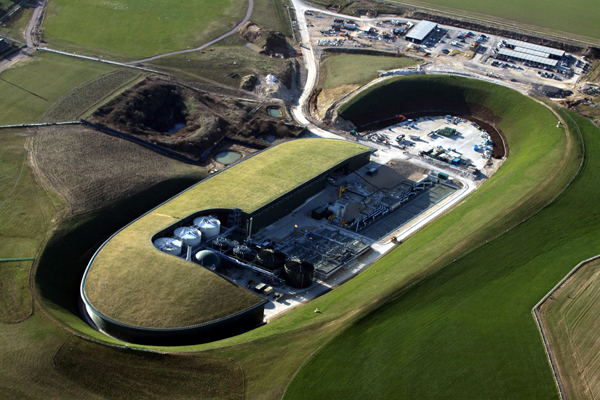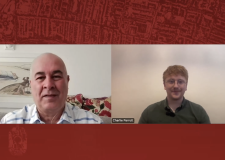Southern Water’s mission for clean water starts in Peacehaven
Southern Water has spent £300m on its new treatment works and sludge recycling centre and seven miles of tunnels.
Frank le Duc finds out why

Southern Water was due to open its new £300 million waste water treatment works and sludge recycling centre in Peacehaven on Monday 14 October. The project was the largest ever undertaken by the company. It’s taken about 20 years to come to fruition and four years of building work. It should result in cleaner seas – and should ensure that European Union (EU) standards are met.
More than 20 million gallons – or 95 million litres – of waste enters Brighton and Hove’s sewers every day.
It will now travel along a big new seven-mile (11km) tunnel and through two pumping stations – on the edge of Brighton and in Telscombe Cliffs – where it will be filtered and treated. The tunnel has an 8ft (2.4m) bore. The treated water will flow out to sea along a one-and-a-half mile (2.5km) outfall.
The Brighton and Hove area was the last in Sussex and among the last in the EU that fell short of European standards for waste water treatment. But not now. Southern Water said: “The scheme ensures that the 95 million litres of waste water produced each day by people in Peacehaven, Telscombe Cliffs, Saltdean, Rottingdean, Ovingdean and Brighton and Hove is treated
to EU standards.
“The new waste water treatment works at Peacehaven is covered by a green roof which is as big as three football pitches and one of the largest in Europe. It is planted with downland grasses to help it blend into the surrounding landscape. Construction of the works started in 2009 on a site covering more than 36 hectares.
“At Peacehaven alone, more than one million cubic metres of earth was moved, all of which was reused on site as part of the extensive landscaping. The new waste water treatment works covers just one third of the construction site, the rest having been returned to agricultural land and a new park for the community.”
Richard Price, Southern Water’s director of capital delivery, said: “There is an immense sense of achievement and pride on site. Our plans to bring cleaner seas to Sussex have been some 20 years in the making so it is fantastic to stand here today and see them finally brought to life. This £300 million scheme is the culmination of many years of hard work.
“This has been a major engineering operation and is the largest ever project that Southern Water has undertaken. Construction took four years and I must thank the communities in which we have worked for their patience and support over that time.” He added that it was on time and had come in within the budget.”
Those with long memories will recall the fuss and anger over the choice of Lower Hoddern Farm for what became known as “Poohaven”. And the long-running roadworks along Brighton seafront concealed work underground on the replacement tunnels. The company is confident that the cost and controversy will prove to have been worthwhile.
DRY FACTS
Average demand for tap water in a normal year in the Brighton supply area is more than 18,000 gallons – or 83 million litres a day. On a hot and dry summer’s day it can rise to almost 23,000 gallons 103 million litres a day.
Southern Water said: “Demand goes up in hot, dry weather because people typically use more water on their lawns and gardens and other seasonal uses like paddling pools.”
The Brighton supply area extends along the coast from the River Adur in the west to Peacehaven in the east. It includes the city of Brighton and Hove and the surrounding area.
Just 13 chalk groundwater sources supply the entire Brighton area and its wider population of 320,000 – and those sources are capable of supplying more than about 24,000 gallons, or 108.5 million litres a day. Water can be piped across from the Worthing supply area to Brighton if required.
MORE BIG PLANS
Southern Water has more big ambitions for the Brighton and Hove area set out in its Business Plan
(for 2015 to 2020) and its Water Resources Management Plan
(for 2015 to 2040). The company said: “Our plan… will deliver the improvements our customers expect. The plan sets out our promises about what we will do
for our customers.
“Under the plan, bills will go up by no more than the rate of inflation (from 2015 to 2020). It will cost £3 billion to deliver our plan.”
Among Southern Water plans are the introduction of catchment management schemes. The goal is to help reduce the amount of nitrates in the water abstracted at four water supply works in the Brighton area by 2024.
Another project will see a pipeline in the pipeline, with one to be built in the Brighton supply area by 2032 to help move water around more easily. And a new water main between Brighton and Shoreham is expected to be in place by 2035.
DRAIN PAIN
Southern Water is running a campaign called Pain in the Drain to try to reduce blockages and associated flooding. The campaign focuses on fat, oil and grease (FOG), which many people pour down sinks, and things such as wet wipes, which many people flush down their toilets.
Blockages can cause toilets and sinks to back up and overflow, which can be unpleasant, distressing and costly, the company said. Fat, oil and grease account for about three in four drain and sewer blockages, according to Southern Water, and more than half of all incidents of sewer flooding. About 200,000 sewer blockages happen every year.
The substances stick to the inside of drains and sewers. Over time, this hardens to form a concrete-like material. It can block the entire pipe and cause flooding as sewage is forced to escape through manholes and into streets and rivers or, even worse, into homes.
More than 3,000 homes are flooded in the South East each year because of fat, oil and grease blockages. It costs about £15 million a year to clear these preventable blockages across the country.
The water company also said: “Build-ups of fat, oil and grease can also put wastewater pumping stations out of action.” It added: “Two billion items are flushed down the toilet each year causing blockages and pollution. “Every day our homes, beaches and rivers come under threat from our own bad habits in flushing the wrong things down the loo.”
It urged people to “bag it and bin it” to prevent the blockages that can lead to homes being flooded and waterways becoming polluted. Southern said: “Sewers and treatment works are built to deal with human waste and water yet every year in the UK we flush away two billion items that shouldn’t go down the loo.
“The only things that should be flushed down the toilet are
the three Ps – pee, poo and paper. Toilet paper decomposes naturally and can be flushed away safely but non-biodegradable items such as wet wipes should be put in the bin.”
For more information, visit www.southernwater.co.uk/paininthedrain




















